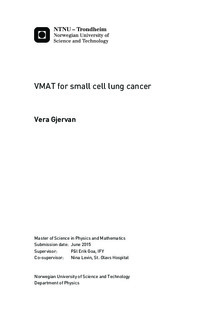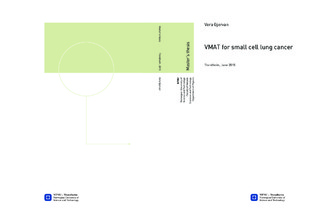| dc.description.abstract | Limited stage small cell lung cancer (SCLC-LS) is an aggressive cancer form affecting a relatively small group of patients. The prognosis for these patients is poor, and those who are treated with radiotherapy often develop serious side effects, indicating a potential room for improvement of the treatment given to these patients. The newest technique for delivering external photon beam radiotherapy, volumetric modulated arc therapy (VMAT), has not yet been used for this patient group at St. Olavs Hospital, and little research has been published on the topic. The purpose of this thesis is to explore the possibilities of using VMAT for SCLC-LS patients, with special consideration to the irradiated lung volume and possible tumor dose escalation.
VMAT plans were simulated using the CT images of 20 SCLC-LS patients previously treated using 3D conformal radiotherapy (3DCRT) at different hospitals in Norway. Dose-volume parameters for target volumes and organs at risk were evaluated and compared with those of the 3DCRT plans originally given to the patients. The probability for radiation pneumonitis was estimated using a normal tissue complication probability (NTCP) model. Tumor dose escalation within the recommended limits for dose to organs at risk was attempted.
Target coverage, conformity, and homogeneity were kept unchanged or slightly improved for all VMAT plans compared to 3DCRT. A significant reduction of all lung dose parameters was achieved, while dose to the esophagus and spinal cord were kept below given constraints. Mean lung dose was reduced from 16.3 Gy to 13.8 Gy, lung V20 from 33.6% to 27.7%, and lung V5 from 59.1% to 52.4%. The average reduction in NTCP values was 34%. Dose escalation above 45 Gy was possible for 17 of the 20 patients studied, with a mean prescribed dose of 59.0 Gy. Lung doses were the main limiting factor for further escalation.
A new treatment planning system, RayStation 4.5 (RaySearch Laboratories) was recently installed and put into clinical use at the radiotherapy department at St. Olavs Hospital. The new VMAT plans were made in this system, while the 3DCRT plans used for comparison were made in a treatment planning system from Oncentra (Elekta). These systems use slightly different versions of the Collapsed Cone algorithm for dose calculation. A brief comparison was done of the resulting dose distributions when using these algorithms. The difference in dose-volume parameters between plans from the two systems were not likely to be clinically relevant.
This study showed that both low lung doses with acceptable tumor doses and high tumor doses with acceptable organ at risk doses are feasible with VMAT. There is always a trade-off between high tumor doses and acceptable organ at risk doses in radiotherapy, and VMAT may make it easier to control this trade-off. VMAT can be introduced either as a substitute for 3DCRT, or an alternative. The potential for decreased lung doses may be especially beneficial in cases where lung dose objectives are not fulfilled using 3DCRT, and it may be natural to start with these cases if VMAT is to be gradually introduced. However, accurate target volume delineation and sufficient compensation for target volume motion is particularly important with the increased target conformity of VMAT. | |

